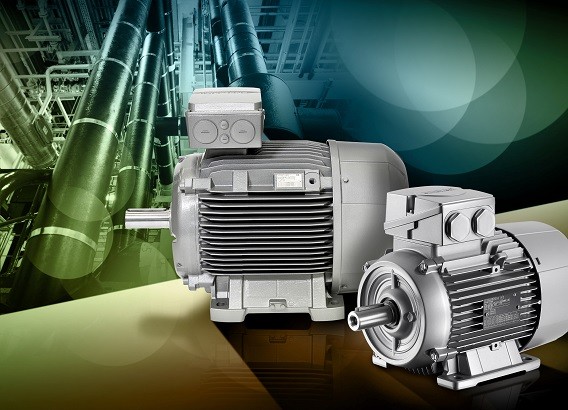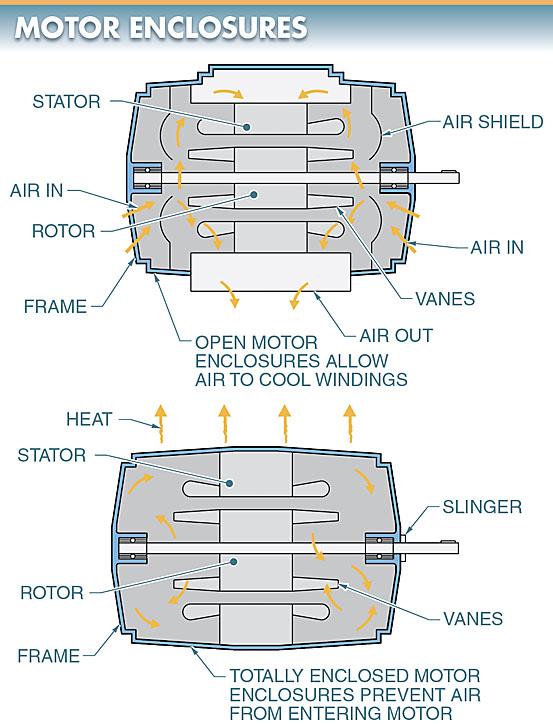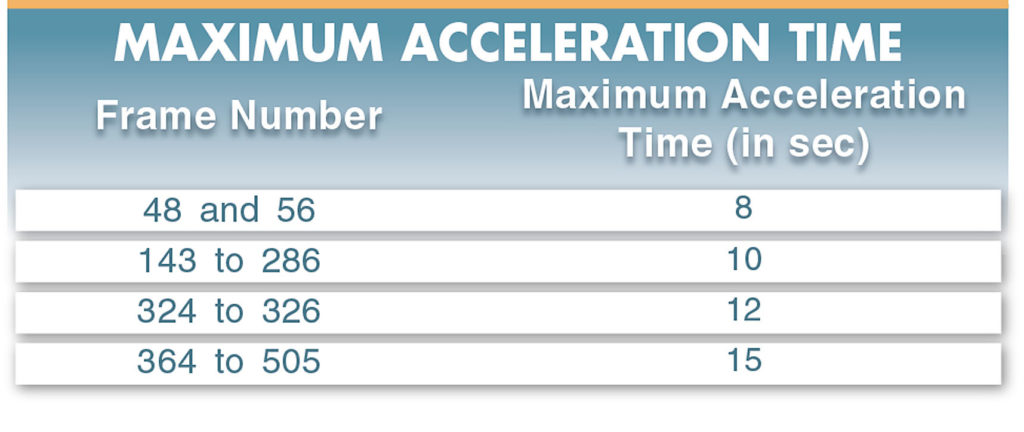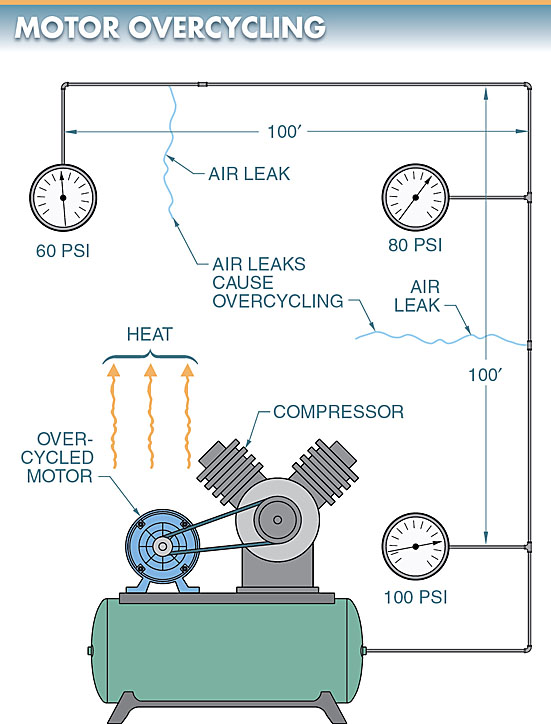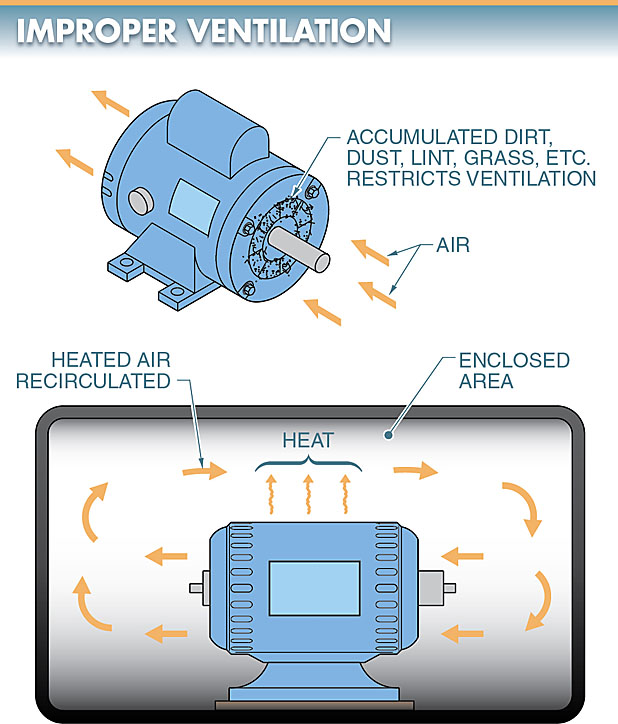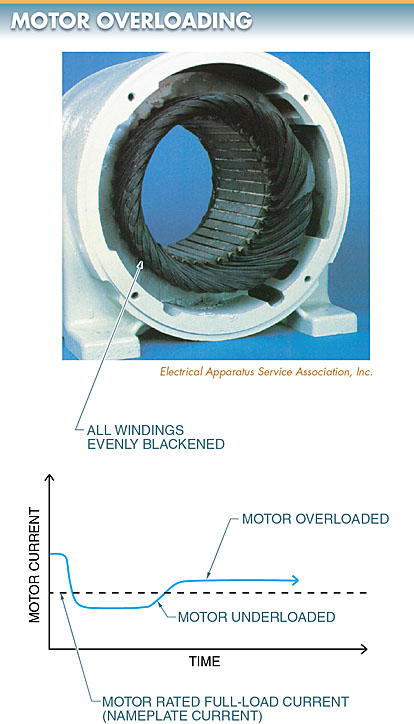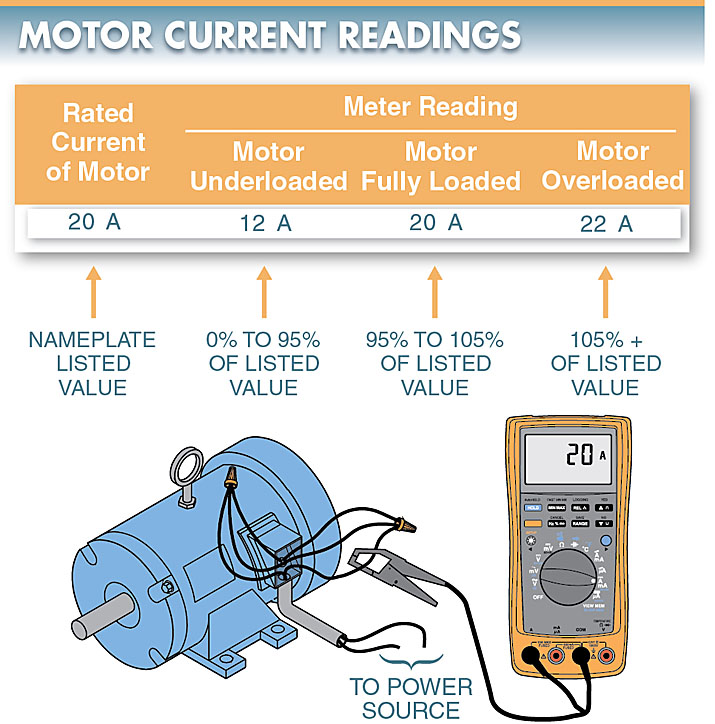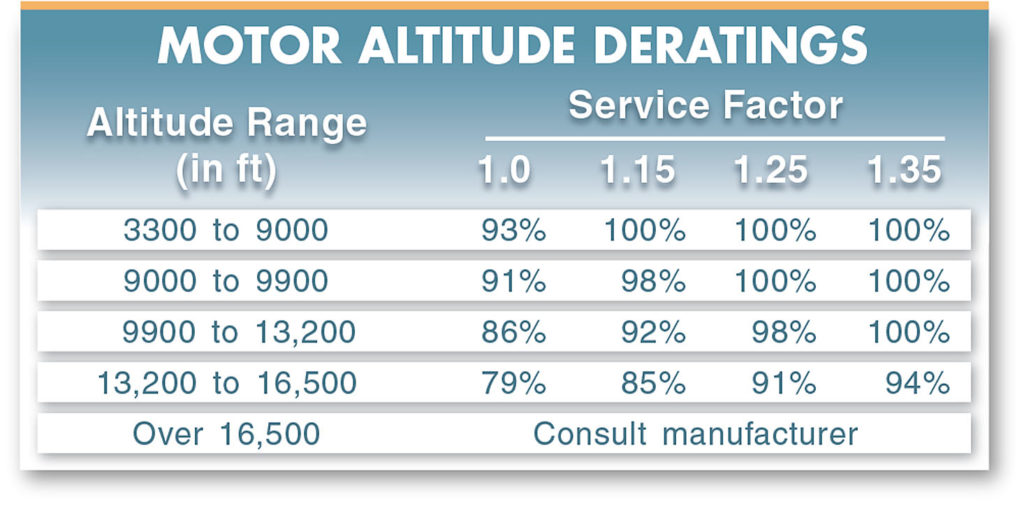Electric motors are very dependable machines. An electric motor gives good service under all operating conditions for which it is designed.
For the safest service possible, the information given on the motor nameplate should be checked before putting a motor into operation. See Figure 1.
The nameplate should be checked to ensure that the proper voltage and current are being used.
Figure 1. Electric Motor nameplate information should be checked to ensure that the proper voltage and current are being used.
A standard electric motor should not be operated in very damp locations or where water may enter the motor frame. Motors are designed for use in specific locations.
Typical enclosures available are open motor enclosures and totally enclosed motor enclosures. See Figure 2. When replacing a motor, it is important to ensure that the motor enclosure meets the proper specifications.
Electric Motor Frame
The frame of a motor should be grounded, especially if the motor is used in a damp location.
If a motor shaft does not rotate after the switch has been turned on, the motor should be unplugged immediately. This prevents the windings from becoming seriously overheated.
To prevent an ordinary Electric Motor from becoming overheated, the air openings on its frame should be kept clear at all times.
When oiling an electric motor, the oil should be applied to the bearings only. The excessive oil used on a motor damages the winding insulation and causes the motor to collect an excessive amount of dirt and dust.
Figure 2. An open electric motor enclosure allows air to flow through the motor to cool the windings. A totally enclosed motor enclosure prevents air from entering the motor.
Allowable Motor Starting Time
The electric motor must accelerate to its rated speed within a limited time period. See Figure 3.
The longer a motor takes to accelerate, the higher the temperature rise in the motor. The larger the load that is placed on the motor, the longer the acceleration time.
The maximum recommended acceleration time depends on the motor frame size. Large motor frames dissipate heat faster than small motor frames.
Figure 3. The electric motor must accelerate to its rated speed within a limited time period.
Over Cycling
Over cycling is the process of turning an electric motor on and off repeatedly.
Motor starting current is usually six to eight times the full-load running current of a motor. Most motors are not designed to start more than 10 times per hour.
Over cycling occurs when an electric motor is at its operating temperature and still cycles on and off. This further increases the temperature of the motor, destroying the motor insulation. See Figure 4.
Open, drip-proof motors rated for continuous duty are the best choice for applications that include over cycling.
When a motor application requires a motor to be cycled often, the following steps should be taken:
- Use a motor with a 50°C rise instead of the standard 40°C.
- Use a motor with a 1.25 or 1.35 service factor instead of a 1.00 or 1.15 service factor.
- Provide additional cooling by forcing air over the motor.
Figure 4. Over cycling is the process of turning the electric motor on and off repeatedly, increasing the temperature of the motor, and destroying the motor insulation.
Heat Problems
Excessive heat is a major cause of electric motor failure and other motor problems. Heat destroys motor insulation, which short-circuits the windings. The electric motor is not functional when motor insulation is destroyed.
The life of the electric motor insulation is shortened as the heat in a motor increases beyond the temperature rating of the insulation. The higher the temperature, the sooner the insulation fails.
The temperature rating of motor insulation is listed as the insulation class. See Figure 5. The insulation class is given in Celsius (°C) and/or Fahrenheit (°F). A motor nameplate normally lists the insulation class of the motor.
Heat buildup in an electric motor can be caused by the following conditions:
- incorrect motor type or size for the application
- improper cooling (normally from dirt buildup)
- excessive load (normally from improper use)
- excessive friction (normally from misalignment or vibration)
- electrical problem (normally voltage unbalance, phase loss, or a voltage surge)
Figure 5. The temperature rating of electric motor insulation is listed as the insulation class.
All electric motors produce heat as they convert electrical energy into mechanical energy. This heat must be removed to prevent the destruction of motor insulation.
Motors are designed with air passages that permit a free flow of air over and through the motor.
Airflow removes heat from a motor. Anything that restricts airflow through a motor causes the motor to operate at a higher than designed temperature.
Airflow through a motor may be restricted by the accumulation of dirt, dust, lint, grass, pests, rust, etc. Airflow is restricted much faster if a motor becomes coated with oil from leaking seals or from over lubrication. See Figure 6.
Figure 6. Anything that restricts airflow through an electric motor causes the motor to operate at a higher than designed temperature.
Overheating can also occur if a motor is placed in an enclosed area. A motor overheats due to the recirculation of heated air when a motor is installed in a location that does not permit the heated air to escape.
Vents added at the top and bottom of the enclosed area allow a natural flow of heated air.
Electric Motor Overloading
An overload is the application of an excessive load to a motor. Motors attempt to drive the connected load when the power is ON. The larger the load, the more power required.
All motors have a limit to the load they can drive. For example, a 5 HP, 460 V, the three-phase motor should draw no more than 7.6 A.
Overloads should not harm a properly protected motor. Any overload presents longer than the delay time built into the protection device is detected and removed.
Properly sized heaters in the motor starter ensure that an overload is removed before any damage is done.
An electrician can observe the even blackening of all motor windings that occurs when a motor has failed due to overloading. See Figure 7.
Figure 7. Overloading causes an even blackening of all motor windings.
The even blackening is caused by the slow destruction of the motor over a long period of time. No obvious damage or isolated areas of damage to the insulation are visible.
Current readings are taken at a motor to determine an overload problem. See Figure 8. A motor is working to its maximum if it is drawing rated current.
A motor is overloaded if it is drawing more than rated current. The motor size may be increased or the load on the motor decreased if overloads are a problem.
Figure 8. Current readings are taken at a motor to determine an overload problem.
TECH FACT
Heat is produced evenly in the motor windings anytime the motor is operated. This heat should be dissipated through the frame of the motor.
Phase imbalance, phase loss, dirt, and poor ventilation around or through the motor can cause uneven heat. Overheated motor insulation at any one point can cause total motor failure.
Infrared (IR) or thermal imaging test tools can be used to check the heat in motor windings as well as heat in motor bearings and couplings.
Altitude Correction
A temperature rise of motors is based on motor operation at altitudes of 3300′ or less. A motor with a service factor of 1.0 is derated when it operates at altitudes above 3300′.
A motor with a service factor above 1.0 is derated based on the altitude and service factor. See Figure 9.
Figure 9. A motor with a service factor of 1.0 is derated when it operates at altitudes above 3300′.
